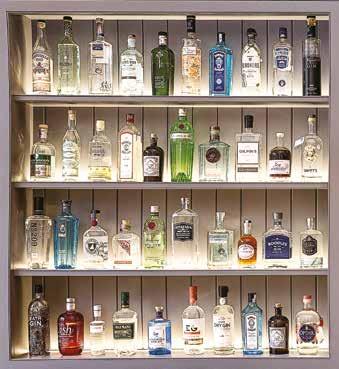
2 minute read
Gail's Guide to Gin
from Cambs July 2020
by Villager Mag
Special Report Gail’s Guide to Gin By Gail Mitchell
I fell in love with gin when I went to a gin tasting event a few years ago. These events are a bit thin on the ground right now for social distancing reasons, so if you are gincurious and wondering where to start I’ll to try to be your guide. Gin is a flavoured alcohol, with juniper as the predominant botanical. Juniper is a fragrant shrub and its aroma and taste should be the signature note in any gin. Even the name ‘gin’ is derived from either the French genièvre or the Dutch jenever, which both mean juniper. You can add other botanical ingredients, but juniper should always be the primary one. There is actually a legal EU definition of gin: it must be a juniper-dominated spirit, with an agricultural origin and a 37.5% ABV. This means that as well as the main botanical being juniper, the base alcohol must be made from something natural such as wheat, barley, rye, molasses, potatoes or grapes, and there must be at least 37.5% of pure alcohol in the total volume of liquid.
Advertisement
London Dry Gin
This doesn’t have to be made in London, it can be made anywhere in the world but it’s important to know that it’s the highest-quality gin you can produce. It has to be made with all-natural ingredients (no artificial flavourings), highquality alcohol and only contain 0.01g of sugar per litre of alcohol. Crucially you can’t add any other flavourings after distillation. It’s the purest form of gin and is a good place to start your gin journey. I would say No. 3 London Dry Gin is one of the best places to start your gin journey. It’s won the world’s best gin 4 times and is a beautiful smooth gin which won’t disappoint.
Regular distilled gin
This is made in a similar way to London Dry Gin but may have flavourings, essences and sugar added to it after the distillation process. Craft distillers have been producing more variety and exciting new flavours recently. Broadly there are herbal gins (less sweet), floral gins (light and fragrant), fruity gins (sweeter) and citrussy gins (light and fresh). Look at the list of botanicals to see which appeal.
Geographical gins
Just as champagne has to come from a specific region in France so certain gins have to come from a particular geographical area. Mahón Gin can only come from Menorca, it’s a sweeter style of gin which comes in various flavours, and Vilnius Gin from Lithuania, which is quite smooth and has a citrussy / pine flavour. The UK used to have a geographical gin - Plymouth gin - but it lost its protected status in 2014. Sloe gin - is a gin liqueur. It contains more sugar and its ABV is between 20-25%, which is below the minimum requirement of a spirit.
Old Tom gins
An older style of gin. These gins are sweeter because in the 18th Century, when gin was also very popular sugar or honey was added to disguise bad-quality gin they used. Nowadays Old Tom Gins are made to a high standard and are the gin you would use in a Tom Collins cocktail, which should be made with soda water rather than tonic, because tonic would add too much sweetness to an already sweet alcohol.










